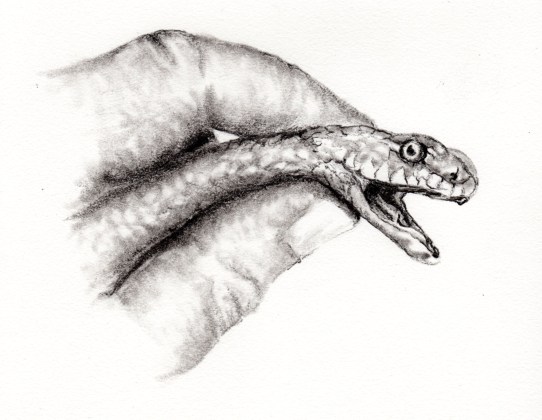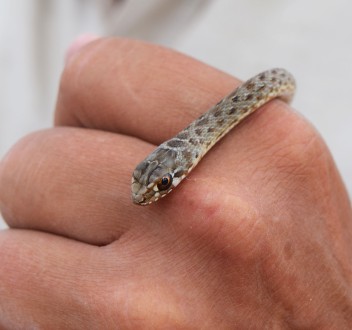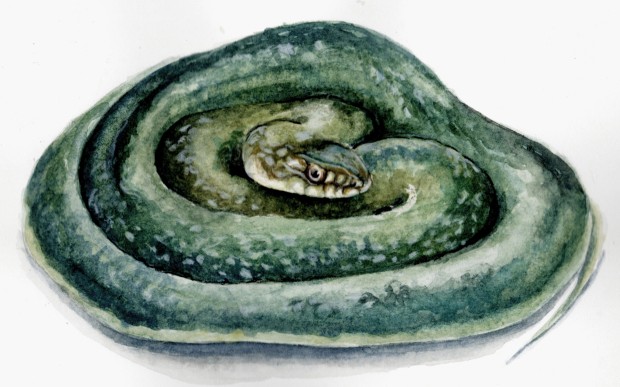Enquanto caminhava a passos largos em direção à torneira e pensava nas plantas que tinha de regar, apercebi-me de um assobio. “Será que já abri a torneira?…” Não, estava fechada. Mas o som continuava. Quando olhei para os fardos de palha, logo ao meu lado direito, lá estava ela, uma cobra rateira, presa numa sobra de rede usada para proteger as plantas.
Numa tentativa de passar pelo “buraco da agulha” ficou entalada, e já apresentava um pequeno inchaço, o que indicava já estar naquela posição há algumas horas. O meu pai, que está bastante mais familiarizado com estes animais do que eu, tratou de a soltar da rede e, após verificar que ela se encontrava em perfeitas condições, devolveu-a à liberdade.
As I strode towards my garden water tap, thinking about what plants i had to shower, I realized there was a whistle sound in the air. “Have I turned on the tap already?” .. No, it was closed. But the sound continued. When I looked at the straw bales, just to my right, i saw her .. a Montpellier snake, caught in a spare mesh that we used to protect our trees and plants.
In an attempt to pass through the “eye of the needle” she got stuck, and already had a small swelling, indicating to be in that situation already for a few hours. My father, who is much more familiar with these animals than I, set her free from the net and after verifying that she was in perfect condition, handed her back to freedom.
A cobra rateira (Malpolon monspessulanus) é considerada o maior ofídio da Península Ibérica, podendo ultrapassar os 2 metros e viver mais de 25 anos. Distribui-se por todo o território nacional e não se encontra, actualmente, na lista das espécies ameaçadas.
Activa durante o dia, com excepção nos meses de mais calor, onde pode adoptar hábitos crepusculares. Robusta, rápida e ágil esta cobra pode demonstrar um comportamento agressivo quando se sente extremamente ameaçada.
The Montpellier snake (Malpolon monspessulanus) is considered the largest snake of the Iberian Peninsula, can exceed 2 meters and live more than 25 years. It is distributed throughout Portugal and is not, presently, in the list of endangered species.
Active during the day, except in the months of more heat where she may adopt crepuscular habits. Robust, fast and agile this snake may show aggressive behaviour when feeling extremely threatened.
É importante referir que esta espécie é opistóglifa, isto é, os dentes inoculadores de veneno encontram-se no maxilar de cima atraz, o que a impede de injetar veneno no ser humano, e, por isso, embora esta possa ser eficazmente assustadora quando bufa e investe contra a ameaça, a sua mordidela não representa qualquer perigo para os humanos.
Excelente trepadora, assim como nadadora, a cobra recorre com frequência a estas duas capacidades, tanto para se proteger ou aquecer como para caçar.
Cabeça pontiaguda, olhos grandes com as escamas supraoculares proeminentes, a natureza concedeu-lhe um ar feroz e sempre atento. Na fase adulta, o seu dorso apresenta colorações bastante variadas, que vão do verde oliváceo até ao castanho acinzentado, com o ventre a destacar-se, exibindo uma coloração amarelada com manchas escuras.
It should be noted that this species injects its low toxicity venom through her rear fangs so although she can be effectively scary when snorting and investing against the threat , her bite is not dangerous for the human being.
Excellent climber as well as swimmer, this snake makes extensive use of these two capacities, either to protect herself, get warmer or hunt.
Pointed head, big eyes with prominent above the eyes scales, nature gave her a fierce and always attentive air. Appearing in varied colorings, from olive green to gray/ brown. The belly stands out, displaying a yellowish bright color with dark spots.
cobra-rateira adulta / adult montpellier snake
cobra-rateira juvenil / juvenile montpellier snake
A dieta deste réptil esta intimamente ligada com a sua envergadura, ou seja, enquanto juvenil a cobra-rateira vai alimentar-se quase exclusivamente de insectos, sendo que, à medida que vai crescendo, começa a caçar outros répteis (lagartixas, outras cobras) pequenos roedores, acabando no ocasional “assalto” ao ninho.
Hibernando de Outubro a Março, a cobra rateira torna-se mais fácil de observar nos meses da Primavera e Verão, durante os quais se dá o acasalamento e a postura dos ovos, assim como a eclosão dos mesmos. Presente numa grande variedade de habitats esta cobra aprecia desde pedreiras e matas a zonas agrícolas ou jardins.
The diet of this reptile is closely linked with its body scale, that is, while juvenile the Montpellier will feed almost exclusively on insects, and as it grows begins to hunt other reptiles (lizards, other snakes) small rodents, ending in casual “robbery” to some bird nest.
Hibernating from October to March, the Montpellier becomes easier to observe in the months of spring and summer, during which takes place the mating season as well as the time to lay the eggs. They are present in a wide variety of habitats this snake will appreciate environments from quarries and forests to agricultural areas or gardens.











Beautiful Snake!! ❤
GostarLiked by 1 person
thank you darling!!
GostarGostar
Incrível!!!
GostarLiked by 1 person
Muito Obrigada!!
GostarGostar